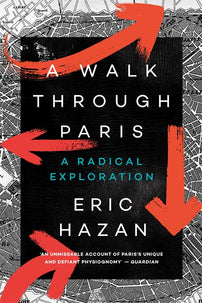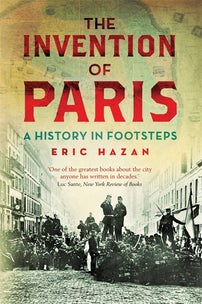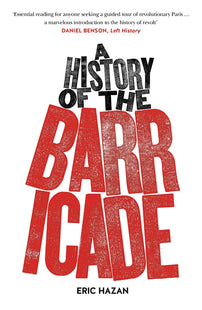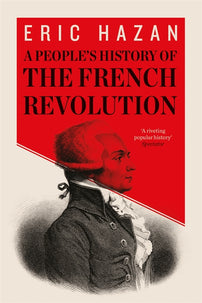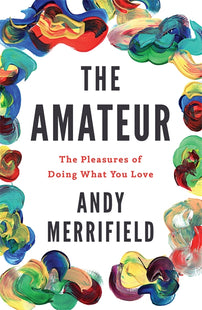Two or Three Things He Knows About Paris
There are few urbanists today who know their city as intimately as Paris’s popular historian, Eric Hazan.

A Walk Through Paris is on sale for 40% off, along with the rest of our French history reading list, until Sunday, April 15 at 11:59pm EST.
There are few urbanists today who know their city as intimately as Paris’s popular historian, publisher and organic intellectual, Eric Hazan. He’s the only writer I’m aware of whose books have indexes for street names. But Hazan doesn’t just know Paris’s backstreets and inner courtyards: this guy seems to know all the names on doorbells, too. Since The Invention of Paris, he’s been knocking on doors and listening to footsteps, harking paeans to his hometown under fire. Hazan takes leave from one of Balzac’s remarks: “old Paris is disappearing with a frightening rapidity.” Balzac is one of Hazan’s heroes, and like the great nineteenth-century creator, Hazan himself isn’t so much a realist portrayer as an urban visionary, an observer of a Paris to come. He’s not one to go in search of lost time, nor even lost steps. Lost steps? There aren’t any.
Hazan’s pages are full of writers lamenting Paris’s perennial sacking — Balzac, Victor Hugo, Chateaubriand, Baudelaire, Louis Chevalier, Guy Debord. And yet, the septuagenarian Hazan is over his grief for a lost loved one. He embraces a future very different from a once glorious past. He’s spent decades inventing another Paris, a popular one. Hazan’s modern day dandies and flâneurs have darker skins and inhabit a Paris beyond the centre, the other side of the Boulevard Périphérique, Pompidou’s dreaded circular expressway, whose jarring construction Godard had highlighted in Two or Three Things I Know About Her. Louis Chevalier had described the litany of urban catastrophes besieging Paris in The Assassination of Paris; Guy Debord’s Panegyric likewise spoke of the city’s ravaging in the “repugnant seventies”; but only Godard, says Hazan in the newly translated A Walk Through Paris, brought home the seriousness of the Périphérique’s threat.
A Walk Through Paris takes us on a stroll from distant south to distant north, from Ivry to Saint-Denis, from one bookstore to another, loosely following Paris’s meridian, its dividing line between east and west. Hazan passes via Luxembourg Gardens and Les Halles, Belleville and Barbès, Montmartre and beyond, perhaps remembering how Jane Jacobs once said there were really only two kinds of people: foot people and car people. Hazan locates himself in the foot-soldiering camp, joining the ranks of his own roster of great walking urbanists — Walter Benjamin, André Breton, Francis Carco, and Debord — for whom Paris was more calling than simply backdrop.
Traversing Paris, Hazan unearths transgressive Paris, most of it long dead and buried. Yet here and there, remnants survive, in the built fabric, in the grubby working class neighbourhoods caught between speculative real estate interests on the one side, and a spectacular (and often tacky) tourist market on the other. Tourists flock to Paris’s lovely museums and historic quartiers, gape at its radiant buildings and monuments; but Paris as a living and breathing organism, Hazan says, lies elsewhere, in the northeastern “red belts” and multicoloured banlieues. Hazan here sees glimmers of renewed urban vitality; this is where a new City of Light will reemerge, if it ever reemerges. Parisian ruling classes have banished so many poorer people from its bourgeois centre that the periphery is now central to the city’s core future.
Hazan’s cityscape is the site of another comédie humaine. First time tragedy, second time farce. The 1850s and 1860s inaugurated an urban practice of divide and rule, of class expulsion through spatial transformation: Haussmannisation. It was a tragic counter-revolution masterminded by Paris’s notorious Prefect, Baron Georges Haussmann, who tore into the medieval city and its old working class neighbourhoods, mobilising public monies to prime the private real estate pump. The sense of loss, the sense of dispossession, was apparent for many poor Parisians back then, and is still felt by their counterparts one hundred and sixty-odd years down the line.
But Hazan’s stomping ground today isn’t only paradigmatic of a once-tragic Haussmannisation; it’s now part of a farcical new global process of divide and rule: let us call it neo-Haussmannisation. Haussmannisation and neo-Haussmannisation share the same lineage. But the primal scene of its progeny needs updating and upgrading. Those grand boulevards still flow with people and traffic, even if the boulevard is now reincarnated in the expressway, and that expressway more often than not is at a standstill, log-jammed every hour. Twenty-first-century grand boulevards flow with energy and finance, with information and communication, and they’re frequently fibre-optic and digitalised, ripping through cyber-space as well as physical space. Neo-Haussmannisation is a global urban strategy that has peripheralised millions of people everywhere. As cities explode into mega-cities, neo-Haussmannisation projects its new urban panorama onto our whole planetary space.
What’s happening in Paris is a microcosm, a cell-form of a broader urban tissue constituted by centres and peripheries threaded together all over the globe. They’re everywhere in opposition to one another, a patchwork quilt of socio-spatial apartheid that goes as much for Paris as for Palestine, for London as for Rio, for Johannesburg as for New York, for Mumbai as for Melbourne. Differences here are differences of degree not substance, not in the essential unity of process, engineered as it is by a global financial ruling class intent on business. The poor Global South exists in northeast Paris, in Queens and in Tower Hamlets; the rich Global North lives high above the streets of Mumbai, flies home in helicopters to Morumbi penthouses in São Paulo.
Fault lines and frontiers between centres and peripheries are no longer some straightforward urban-rural, city-suburb divide, nor even anything Global North versus Global South. Instead, centres and peripheries are immanent within the global accumulation of capital. Capital flows into real estate and land, commodifies space, fracks value from places and location. Its agents and institutions constitute a new aristocratic elite, growing rich from ground rents and interest-bearing capital. Land itself has become a pure financial asset. Profitable locations get pillaged as investment flows become torrential, just as other sectors and places are asphyxiated through disinvestment. Centrality thereby creates its own periphery. Separate universes — centre and periphery — exist side-by-side, everywhere, cordoned off from one other.
A lot of A Walk Through Paris reads like a damning autopsy of the massacre of Paris’s urban tissue: the demolition of old jewel buildings, the unnatural levelling of its topography, faults of alignment, the amputation of acute angles, crappy architecture with little sensitivity to the neighbourhood’s past or people’s real needs. It’s an urbicide engineered by land-grabbing developers and greedy financiers. Hazan also recognises how spatial apartheid is kept in place by an ongoing civil war. Paramilitary policing in Palestine serves as something of a model for policing the Parisian periphery. Jerusalem isn’t any further from Ramallah than Drancy is from Notre-Dame. Paramilitary manoeuvring is different from the classical pages of Clausewitz, where war is staged on an open battlefield. War no longer involves grandiose campaigns by troops but is a micro-everydayness of peacetime occupation, a dogged affair in which the police and the paramilitary play interchangeable, often indiscernible, roles. The terrain of neo-Haussmannist civil war is more claustrophobic and more fluid, more intensive as well as more extensive.
Hazan says Auguste Blanqui, the fascinating conspiratorial figure whom Walter Benjamin and Baudelaire both admired, remains instructive for radical politics. Blanqui knew that urban space isn’t just the theatre of confrontation; it’s also the means and the stake, the battleground of a guerrilla warfare that builds barricades, that occupies buildings and strategic spaces, that deploys “the methodology of moving through walls.” Blanqui’s spirit, like Balzac’s, haunts Hazan’s A Walk Through Paris. He’s a living phantom who darts out on every street corner, alive and apparently well, still the grand master of a pet Hazan concept: insurrection.
Little wonder Hazan’s own publishing house, La fabrique, first made public that most incendiary of insurrectional tracts, The Coming Insurrection. The coming insurrection, Hazan thinks, won’t erupt in bourgeois Paris. André Breton had uttered as much in Nadja, seeing office workers clear out of work near rue Lafayette, alienated and atomised. “I unconsciously watched their faces, their clothes, their way of walking,” Breton wrote. “No, it was not yet these who would be ready to create the Revolution.” It’s the new “dangerous classes” who’ll create the Revolution, who’ll create a popular urbanism, swarming the centres they surround; and maybe, just maybe, one day they might reclaim that centre. Hazan doesn’t speak of any “right to the city” as his organising banner. His model as well as his mad love is the “June Days” of 1848, more so than the 1871 Commune.
The Commune, Hazan says, started off as a patriotic upsurge, a gesture of national pride, before it became a revolutionary social movement. The June Days of 1848, on the other hand, were an insurrection of the sans-culottes from the very beginning, one that can still set the terms in our day. Even Alexis de Tocqueville, the conservative voice of order, marvelled at those June Days in his Recollections (staple reading for Guy Debord): “the greatest and strangest insurrection that had ever taken place in our history.” Hazan cites Tocqueville almost describing Occupy, circa 2011: “the greatest because insurgents were fighting without a battle cry, leaders, or flag, and yet they showed wonderful powers of coordination.”
The June Days were a revolt initiated by an anonymous rank-and-file, by a nobody urban proletariat, ordinary men and women “who gave events their colour and explain in part why they’re now forgotten.” 1848 is the most important insurrection in working class history, says Hazan, because it marked the severing of an implicit pact, the end of an illusion: that the people and the bourgeoisie, hand-in-hand, were going to finish what they’d started in 1789.
Today, we’ve seen another illusion put to an end: that a paternal capitalism will give ordinary people a break, that a bourgeoisie and working class might establish a just social contract together. All bets are now summarily off. What we’ve seen instead is the end of an epoch of expectations: expectations of steady work, with decent pay, with benefits, with security and pensions; the whole bit. These days, there can be no expectations in life, except those you create yourself, invent yourself, including the insurrection — an insurrection in which economic self-empowerment would need to encounter political collective empowerment; the favelas as well as financial districts, banlieues as well as bidonvilles, the malls as well as Main streets will all now need occupying.
At that point, the barricades wouldn’t so much go up in the city; more that the barricades separating centres from peripheries would be torn down, removed from within the tissue of neo-Haussmannite urban space. Barricades can no longer simply be manned to defend inwardly. They’ll need to be flexible and portable — and outward looking. They’ll need to move between nodes, disrupt and block, foster new life within. And they’ll need to be mobilised to tear down barriers that keep people apart, that trap people in, that peripheralise. The latter sort of barricades are walls of fear that need smashing down like a veritable storming of the Bastille, so that new spaces of encounter can be formed — new agoras for assemblies of the people.
The greatest poet of Haussmannisation, Charles Baudelaire, might also be the greatest bard of neo-Haussmannisation. Baudelaire witnessed Haussmann annihilate whole neighbourhoods that had lived and evolved, tightly knitted, for centuries. The grand boulevards prized open the whole city to its inhabitants, creating a modern form of urban publicity — Baudelaire’s great muse. In one of his Paris Spleen poems, “The Eyes of the Poor,” Baudelaire shows what this new kind of extrovert urbanisation could do to private bodies in the public realm. Two young lovers sit near the window of a dazzling new café, lining one of Haussmann’s newly minted boulevards. They dreamily look at each other. They’re inside, sharing one another’s company, admiring one another, yet through the window they’re able to survey the gaiety and bustle outside, on the street.
Before long, a ragged homeless family passes by. Enamoured by the café’s opulence, they stop. They peer in. A child presses his nose against the gleaming windowpane, admiring the décor and people inside. “How beautiful it is!” Baudelaire has the rag-picking family cry out. “How beautiful it is!” But they know it’s not for them, not their world. Their fascination is admiring, not hostile. The male lover is touched by “the family of eyes” outside. He feels a strange kinship with them, despite the social distance. But his lover is unmoved. She wants the patron to shoo them away, to move them on, someplace else, anywhere out of sight. “These people with their great saucer eyes,” Baudelaire has her shriek, “they’re unbearable.” Just then the two lovers love each other a little less.
In Haussmann’s urban reality, private joys sprang from open public spaces. You could be private in the crowd, alone yet amid people, inside on the outside, outside on the inside. There were walls and there was transparency, there was social closure and physical openness. Baudelaire’s “Eyes of the Poor” evoked the paradox of this thoroughly modern form of capitalist urbanisation. Poor people could at last see what rich people were up to. Yet Baron Haussmann’s spadework pales compared with the creative destruction wrought by global neo-Haussmannisation, which has uprooted and displaced millions and millions of Baudelairean ragpickers.
Now, this “family of eyes” is global. Those “great saucer eyes” are somehow all-seeing, and, with the internet and WikiLeaks, sometimes all-knowing. People can glimpse the global elite along this information boulevard as never before, glimpse them through the windowpanes of hyper-modern global-urban life. Can a global family of eyes encounter itself as a polyglot international, as an emerging citizenry that might one day repossess what has been dispossessed? Those big saucer eyes now look on with indignation as well as awe. Now, there’s not so much a world to win as a whole world to occupy, a whole world that’s really people’s extended backyard.
Andy Merrifield is the author of nine books. His many articles, essays and reviews have appeared in the Nation, Harper’s, Adbusters, New Left Review, Dissent, the Brooklyn Rail, and Radical Philosophy. He is a prolific writer about urbanism and social theory, with titles credited to him including The New Urban Question and Magical Marxism. He has also published three intellectual biographies, of Henri Lefebvre, Guy Debord and John Berger, as well as a popular travelogue, The Wisdom of Donkeys.
[book-strip index="1" style="display"]